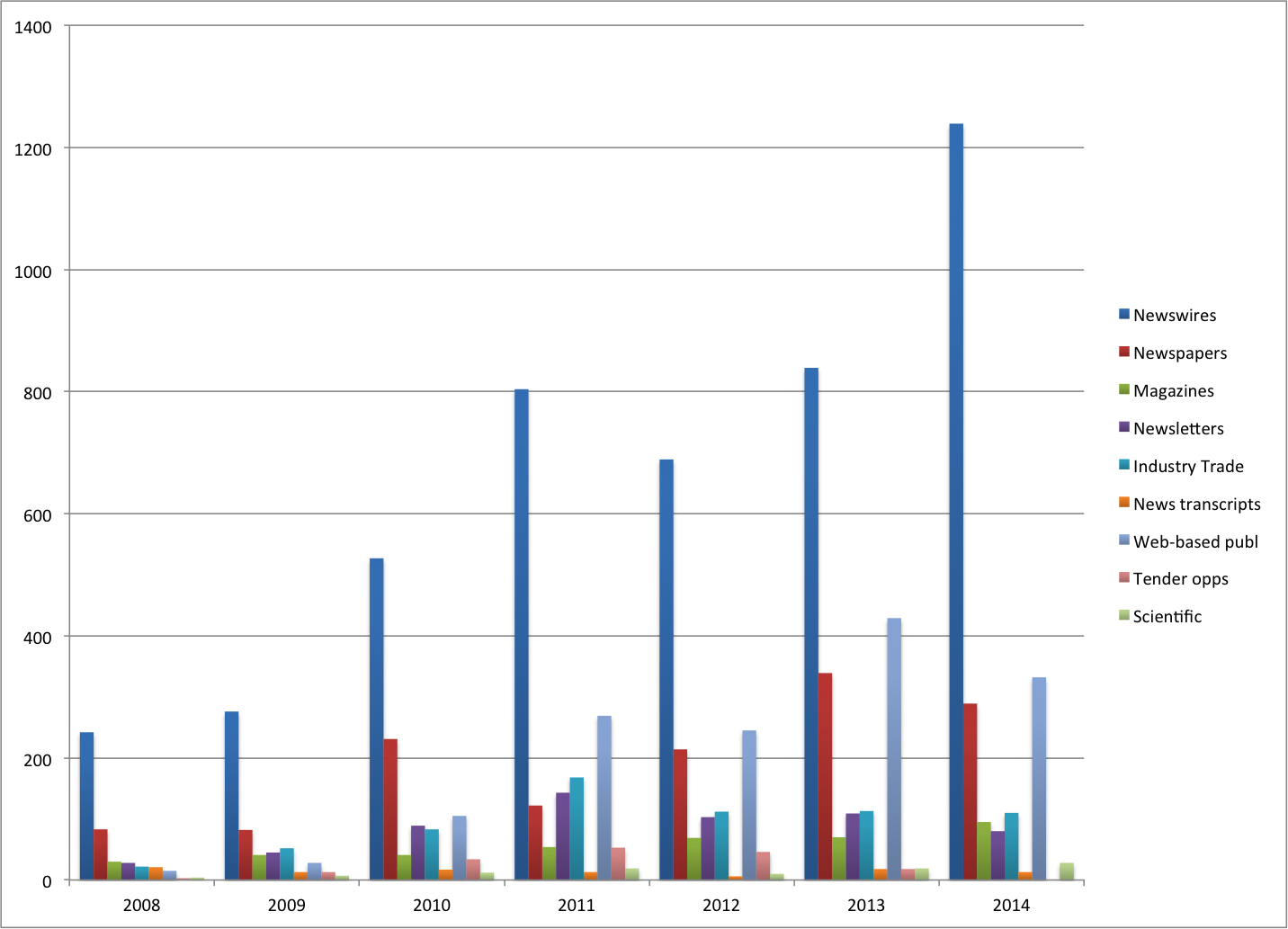
December 31, 2014, by Brigitte Nerlich
Synthetic biology markets: Opportunities and obstacles
As some people know from my previous posts on synthetic biology, I am interested in tracing how synthetic biology is made public in the news media and whether or how it is becoming a matter of public debate.
“Synthetic biology is an emerging area of research and is broadly described as the design and construction of novel organisms or devices, artificial biological pathways, and the redesign of existing natural biological systems.” (MarketsandMarkets Analysis, 2014) (more definitions here)
I have argued that synthetic biology has not attracted much attention in the press and has not led to any major news-mediated public debates, for example in comments underneath news articles or blogs. I also argue that only once this happens a more public debate about synthetic biology, including science and society issues such as responsible research and innovation, can happen; although that might also, paradoxically, be too late.
Synthetic biology in the ‘news’
In this post I want to dig a bit deeper into this conundrum. I therefore went back to my trusted source for all things related to news data, namely LexisNexis. I used ‘synthetic biology’ as a search term to search ‘All English Language News’ and charted recent developments over the last 16 years, that is, from two years before Craig Venter’s major announcement about synthetic biology to now. I disaggregated news items according to news sources, such as, for example, ‘Newswires and press releases’, ‘Newspapers’, ‘Magazines’, ‘Industry and Trade press’ and so on. As you’ll see from the following graph, the ‘news’ about synthetic biology is generally dominated by ‘newswires and press releases’ (blue), which include news about the ups and downs in share values for business such as Amyris, for example.
‘Synthetic biology’ in All English Language News (LexisNexis, high similarity setting)
Newspapers (red) only make up a small part of the ‘news’ about synthetic biology, and, although interest hasn’t been dwindling since 2010, as I expected, it has also not increased massively. This seems to indicate that synthetic biology does not yet attract a lot of ‘public interest’ but does attract a lot of market interest.
Synthetic biology: opportunities for growth
When looking through some reports on synthetic biology published towards the end of this year, my eyes fell on a short market report published by M2 PressWIRE. I then followed the link to the press release online, which proved very interesting. Unfortunately, I could not consult the whole report, as that would have cost me about $5000.
The article by M2 PressWIRE appeared on 23 December 2014 and was entitled “Synthetic Biology Market worth $ 5,630.4 Million by 2018”. It makes some interesting points about the reasons why there is such a growth in the synthetic biology market: “Over the years, the demand for synthetic biology is likely to increase owing to the increasing R&D expenditure in pharmaceutical and biotechnology companies, growing demand for synthetic genes, rising production of genetically modified crops, and incessantly rising funding in the field of synthetic biology.” (Italics added)
Synthetic biology: obstacles to growth
The article highlights that there are however also some obstacles to growth. It points out that “ethical and social issues such as biosafety and biosecurity are major factors that are restricting the growth of this market. Furthermore, rising concerns over fuel consumption and increasing demand for protein therapeutics are likely to create opportunities for the synthetic biology market. However, standardization and integration of biological parts at system-level still remains a challenge for this market.” (Italics added)
In the online version of the press release the word ‘restraining’ is used instead of ‘restricting’: “However, ethical and social issues such as biosafety and biosecurity are the major factors restraining the growth of this market.” (MarketsandMarkets Analysis, 2014)
What sells? Who sells?
Not withstanding such obstacles, where does growth in synthetic biology occur? The online overview sorts potential growth areas in terms of tools, technology and application (and if you have the money you can of course order the report and read more about each item on the list).
Tools
- Xeno-nucleic Acids (XNA)
- Oligonucleotides
- Chassis Organisms
- Enzymes
- Cloning and Assembly kits
Technology
- Enabling Technologies
- Bioinformatics
- Gene Synthesis
- Genome Engineering
- Microfluidics
- Measurement and Modeling
- Nanotechnology
- Cloning and Sequencing
- Site-saturation Mutagenesis
- Enabled Technologies
- Pathway Engineering
- Next-generation Sequencing
Application
- Environmental Application
- Bioremediation
- Whole-cell Biosensors
- Medical Application
- Artificial Tissue and Tissue Regeneration
- Drug Discovery and Therapeutics
- Pharmaceuticals
- Industrial Application
- Biofuels and Renewable Energy
- Biomaterials and Green Chemicals
- Industrial Enzymes
Who are the biggest players in the synthetic biology market? It appears that North America is the market leader, followed by Europe, Asia and the Rest of the World. “Some of the major players in the global market include Amyris, Inc. (U.S.), DuPont (U.S.), GenScript USA Inc. (U.S.), Intrexon Corporation (U.S.), Integrated DNA Technologies (IDT) (U.S.), New England Biolabs, Inc. (NEB) (U.S.), Novozymes (Denmark), Royal DSM (Netherlands), Synthetic Genomics, Inc. (California), and Thermo Fisher Scientific, Inc. (U.S.).”
Synthetic biology, markets and responsible research and innovation
What does all this mean in terms of responsible research and innovation, an issue that interests me as a social scientist embedded in a Synthetic Biology Research Centre? As the newswire said, research in synthetic biology attracts “incessantly rising funding” and innovation in synthetic biology in the US, and increasingly so in Europe, is moving steadily ahead. How can this research and innovation be carried out ‘responsibly’ – a question asked by all major research funders in Europe?
The concept of Responsible Research and Innovation (RRI) is still hotly debated, but the following aspects of RRI, as sumarised by the think-tank MATTER provide a general flavour of what RRI is all about: RRI has “a deliberate focus on socially or environmentally beneficial results”; it stipulates “the continuous and consistent involvement of society in the research and innovation process”; it involves the assessing of “social, ethical and environmental impacts alongside commercial and scientific considerations”; it also involves the “use of oversight mechanisms to anticipate and manage problems and opportunities”; and more generally, RRI should ensure that “openness and transparency are an integral component of research and innovation” (italics added). How can this work within a growth industry and a growing market in synthetic biology tools, technologies and applications?
As we have seen, ethical and social issues are regarded as obstacles, restrictions and restraints that might hamper commercial growth, rather than as integral to a responsible innovation and commercialisation process. This industrial perception of ‘ethical and social issues’ may hamper, restrict and constrain more open and transparent public deliberations about synthetic biology and might be difficult to overcome.
Despite a very long list of tools, technologies and applications, ranging from medicine to alternative fuels and beyond, only biosafety and biosecurity are mentioned by market researchers as potential ethical and social issues related to synthetic biology. This is interesting in a context where, as some social scientists have argued, “concerns about the biosecurity threat posed by synthetic biology are not only exaggerated, but are, more importantly, misplaced” (Marris et al., 2014).
If indeed any of the businesses mentioned above were to get involved in RRI (beyond considerations of Corporate Social Responsibility, business ethics, and legal and environmental safeguards), a much wider array of social and ethical issues would have to be tackled over and above biosafety and biosecurity. These would be specific to the ‘synthetic biology’ in question, and differ substantially between say, “bioinformatics”, “tissue regeneration” and “biofuels” and “green chemicals”.
Talking with members of the public about such issues may be quite difficult for two reasons: first, there is arguably a real news vacuum about most of these technologies, so getting trusted information might be difficult; second, the market might be growing and diversifying faster than RRI efforts around synthetic biology. What can be done in such a situation? Suggestions welcome!
Epilogue
No sooner had a drafted this post, when an item appeared in my twitter stream that is important in this context: An EU “Public Consultation on the preliminary opinion on Synthetic Biology II“.
On p. 14 of the document, just underneath a definition of RRI, one reads: “It is vital to recognise the importance of maintaining public legitimacy and support. To achieve this, scientific research must not get too far ahead of public attitudes and potential applications should demonstrate clear social benefits. Furthermore, the potential benefits of the technology and the risks must not be overhyped creating unrealistic hopes that cannot be fulfilled and/or public anxiety” etc. – these pages are worth reading in the context of RRI and the hopes invested in this approach, especially its use to steer innovation towards social benefits.
Added 5 January, 2015: Important article by Claire Marris dealing with similar issues: http://www.tandfonline.com/doi/full/10.1080/09505431.2014.986320#tabModule
Image: Philippine stock market board, Wikimedia Commons


[…] Read More […]
[…] of these 1308 articles 874 are Newswires and only 176 are proper newspaper articles. This shows again that the drivers of bioeconomy news, just as with synthetic biology, are industry and academia, not […]